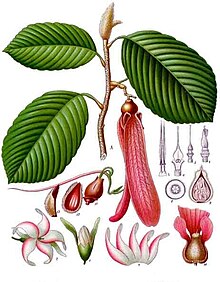Dipterocarpus retusus, commonly known as hollong,[3] is a large tree and perhaps the best known species in the genus Dipterocarpus. It is native to China, Vietnam, Philippines, Laos, Cambodia, Malaysia, Indonesia, Myanmar, and India.[1][4] The tree, some 20–30 metres (70–100 ft) tall, is found in Cambodia in dense forests of the plains, common on hillsides and along rivers and in forests between 800 m (2,600 ft) and 1,500 m (5,000 ft) altitude.[4]
| Dipterocarpus retusus | |
|---|---|

| |
| from Koehler's Medicinal-Plants (1887) | |
| Scientific classification | |
| Kingdom: | Plantae |
| Clade: | Tracheophytes |
| Clade: | Angiosperms |
| Clade: | Eudicots |
| Clade: | Rosids |
| Order: | Malvales |
| Family: | Dipterocarpaceae |
| Genus: | Dipterocarpus |
| Species: | D. retusus
|
| Binomial name | |
| Dipterocarpus retusus | |
| Synonyms[2] | |
| |


Hollong is the state tree of Assam and Arunachal Pradesh, India.[5] In India, the timber is used for plywood and making various containers. In China, the timber is used in construction.[1] Hollong is a sacred tree for Moran community of Assam.[citation needed]
Uses
editIt is farmed for its timber and resin. In Cambodia, the resin is collected by people in the mountainous regions, in order to make torches and candles, while the wood is used in construction to make columns and boards.[4]
References
edit- ^ a b c Ly, V.; Nanthavong, K.; Pooma, R.; Luu, H.T.; Nguyen, H.N.; Vu, V.D.; Hoang, V.S.; Khou, E.; Newman, M.F. (2017). "Dipterocarpus retusus". IUCN Red List of Threatened Species. 2017: e.T32400A2817693. doi:10.2305/IUCN.UK.2017-3.RLTS.T32400A2817693.en. Retrieved 19 November 2021.
- ^ a b "Dipterocarpus retusus". Plants of the World Online. Royal Botanic Gardens, Kew. Retrieved 18 April 2019.
- ^ "Dipterocarpus retusus". Germplasm Resources Information Network. Agricultural Research Service, United States Department of Agriculture. Retrieved 18 April 2019.
- ^ a b c DY PHON, Pauline, 2000, Plants Used In Cambodia, printed by Imprimerie Olympic, Phnom Penh
- ^ "State Trees and Flowers of India". flowersofindia.net. Retrieved 10 January 2021.
